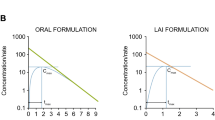Abstract
Purpose: To compare the performance of the standard lag time model (LAG model) with the performance of an analytical solution of the transit compartment model (TRANSIT model) in the evaluation of four pharmacokinetic studies with four different compounds. Methods: The population pharmacokinetic analyses were performed using NONMEM on concentration–time data of glibenclamide, furosemide, amiloride, and moxonidine. In the TRANSIT model, the optimal number of transit compartments was estimated from the data. This was based on an analytical solution for the change in drug concentration arising from a series of transit compartments with the same first-order transfer rate between each compartment. Goodness-of-fit was assessed by the decrease in objective function value (OFV) and by inspection of diagnostic graphs. Results: With the TRANSIT model, the OFV was significantly lower and the goodness-of-fit was markedly improved in the absorption phase compared with the LAG model for all drugs. The parameter estimates related to the absorption differed between the two models while the estimates of the pharmacokinetic disposition parameters were similar. Conclusion: Based on these results, the TRANSIT model is an attractive alternative for modeling drug absorption delay, especially when a LAG model poorly describes the drug absorption phase or is numerically unstable.
Similar content being viewed by others
References
Rowland M and Tozer TN (1994). Clinical pharmacokinetics, concepts and applications. Williams and Wilkins, Baltimore
Nerella NG, Block LH and Noonan PK (1993). The impact of lag time on the estimation of pharmacokinetic parameters. I. One-compartment open model. Pharm Res 10(7): 1031–1036
Agoram B, Woltosz WS and Bolger MB (2001). Predicting the impact of physiological and biochemical processes on oral drug bioavailability. Adv Drug Deliv Rev 50(Suppl 1): S41–S67
Yu LX and Amidon GL (1999). A compartmental absorption and transit model for estimating oral drug absorption. Int J Pharm 186(2): 119–125
Karlsson MO, Jonsson EN, Wiltse CG and Wade JR (1998). Assumption testing in population pharmacokinetic models: illustrated with an analysis of moxonidine data from congestive heart failure patients. J Pharmacokinet Biopharm 26(2): 207–246
Rydberg T, Jonsson A, Karlsson MO and Melander A (1997). Concentration–effect relations of glibenclamide and its active metabolites in man: modelling of pharmacokinetics and pharmacodynamics. Br J Clin Pharmacol 43(4): 373–381
Rydberg T, Jonsson A and Melander A (1995). Comparison of the kinetics of glyburide and its active metabolites in humans. J Clin Pharm Ther 20(5): 283–295
Rydberg T, Jonsson A, Roder M and Melander A (1994). Hypoglycemic activity of glyburide (glibenclamide) metabolites in humans. Diabetes Care 17(9): 1026–1030
Sheiner LB and Beal SL (1992). NONMEM users guide: NONMEM project group. University of California, San Francisco
Osterberg O, Savic RM, Karlsson MO, Simonsson US, Norgaard JP and Walle JV (2006). Pharmacokinetics of desmopressin administrated as an oral lyophilisate dosage form in children with primary nocturnal enuresis and healthy adults. J Clin Pharmacol 46(10): 1204–1211
Jonsson EN and Karlsson MO (1999). Xpose—an S-PLUS based population pharmacokinetic/pharmacodynamic model building aid for NONMEM. Comput Methods Programs Biomed 58(1): 51–64
Lindbom L, Pihlgren P and Jonsson N (2005). PsN-Toolkit—a collection of computer intensive statistical methods for non-linear mixed effect modeling using NONMEM. Comput Methods Programs Biomed 79(3): 241–257
Sheiner LB (1986). Analysis of pharmacokinetic data using parametric models. III. Hypothesis tests and confidence intervals. J Pharmacokinet Biopharm 14(5): 539–555
Wade JR, Kelman AW, Howie CA and Whiting B (1993). Effect of misspecification of the absorption process on subsequent parameter estimation in population analysis. J Pharmacokinet Biopharm 21(2): 209–222
Rousseau A, Leger F, Le Meur Y, Saint-Marcoux F, Paintaud G and Buchler M (2004). Population pharmacokinetic modeling of oral cyclosporin using NONMEM: comparison of absorption pharmacokinetic models and design of a Bayesian estimator. Ther Drug Monit 26(1): 23–30
Sun YN and Jusko WJ (1998). Transit compartments versus gamma distribution function to model signal transduction processes in pharmacodynamics. J Pharm Sci 87(6): 732–737
Friberg LE, Freijs A, Sandstrom M and Karlsson MO (2000). Semiphysiological model for the time course of leukocytes after varying schedules of 5-fluorouracil in rats. J Pharmacol Exp Ther 295(2): 734–40
Author information
Authors and Affiliations
Corresponding author
Rights and permissions
About this article
Cite this article
Savic, R.M., Jonker, D.M., Kerbusch, T. et al. Implementation of a transit compartment model for describing drug absorption in pharmacokinetic studies. J Pharmacokinet Pharmacodyn 34, 711–726 (2007). https://doi.org/10.1007/s10928-007-9066-0
Received:
Accepted:
Published:
Issue Date:
DOI: https://doi.org/10.1007/s10928-007-9066-0




